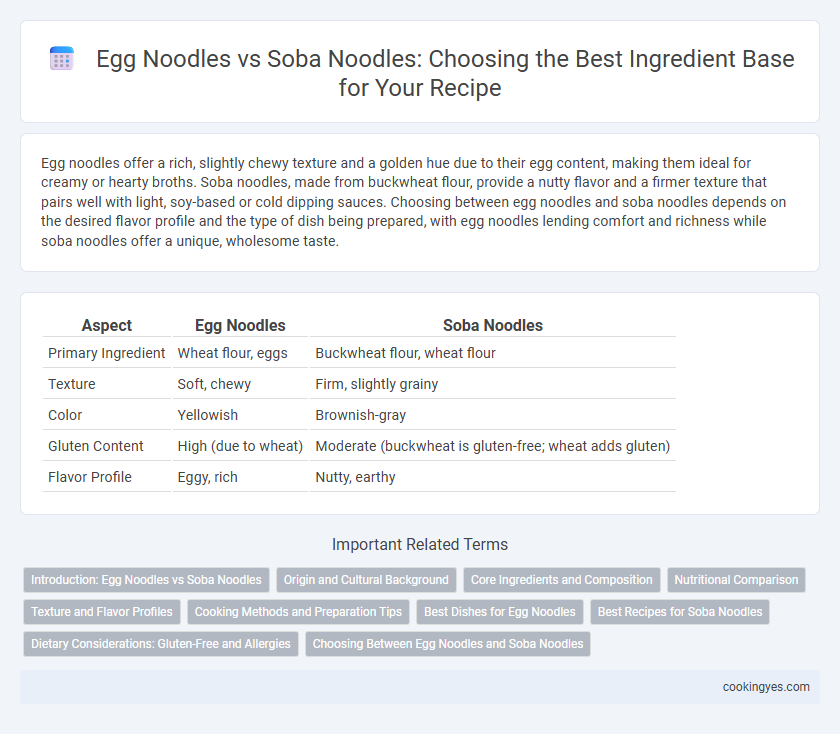Egg noodles offer a rich, slightly chewy texture and a golden hue due to their egg content, making them ideal for creamy or hearty broths. Soba noodles, made from buckwheat flour, provide a nutty flavor and a firmer texture that pairs well with light, soy-based or cold dipping sauces. Choosing between egg noodles and soba noodles depends on the desired flavor profile and the type of dish being prepared, with egg noodles lending comfort and richness while soba noodles offer a unique, wholesome taste.
Table of Comparison
| Aspect | Egg Noodles | Soba Noodles |
|---|---|---|
| Primary Ingredient | Wheat flour, eggs | Buckwheat flour, wheat flour |
| Texture | Soft, chewy | Firm, slightly grainy |
| Color | Yellowish | Brownish-gray |
| Gluten Content | High (due to wheat) | Moderate (buckwheat is gluten-free; wheat adds gluten) |
| Flavor Profile | Eggy, rich | Nutty, earthy |
Introduction: Egg Noodles vs Soba Noodles
Egg noodles utilize wheat flour and eggs as their primary ingredients, offering a rich, tender texture and yellow hue, commonly found in various Asian and European cuisines. Soba noodles are made predominantly from buckwheat flour, lending a nutty flavor and a darker, earthy tone while providing a gluten-free alternative suitable for those with dietary restrictions. Both noodle types serve distinct culinary roles, with egg noodles preferred for their elasticity and soba favored for their unique flavor profile and nutritional benefits.
Origin and Cultural Background
Egg noodles originated in Chinese cuisine, characterized by their rich texture and yellow hue derived from wheat flour and eggs, often used in soups and stir-fries. Soba noodles have deep roots in Japanese culture, made primarily from buckwheat flour, celebrated for their nutty flavor and nutritional benefits, commonly served cold or in hot broth. Each noodle type reflects its cultural significance and regional ingredient availability, influencing traditional culinary practices in East Asia.
Core Ingredients and Composition
Egg noodles are made primarily from wheat flour, eggs, and water, resulting in a chewy texture and rich flavor due to the egg content. Soba noodles are composed mainly of buckwheat flour, sometimes blended with wheat flour, which gives them a nutty taste and darker color while offering higher protein and fiber content. The core ingredient difference impacts cooking methods and nutritional profiles, with egg noodles providing more moisture and softness and soba noodles lending an earthier flavor and firmer bite.
Nutritional Comparison
Egg noodles typically contain more protein and fat due to the inclusion of eggs, providing approximately 7 grams of protein and 3 grams of fat per 100 grams. Soba noodles, made primarily from buckwheat flour, offer higher fiber content and essential minerals like manganese and magnesium, with around 8 grams of protein and 5 grams of fiber per 100 grams. The glycemic index of soba noodles is lower than that of egg noodles, making them a better option for sustained energy and blood sugar regulation.
Texture and Flavor Profiles
Egg noodles feature a rich, slightly chewy texture with a golden hue, offering a mild, savory flavor derived from wheat flour and eggs. In contrast, soba noodles, made primarily from buckwheat flour, present a firmer, grainier texture accompanied by a distinctive earthy and nutty taste. The choice between egg noodles and soba noodles influences the overall dish, as egg noodles provide a soft, silky mouthfeel while soba noodles contribute a robust, hearty character.
Cooking Methods and Preparation Tips
Egg noodles require boiling in salted water for 3-5 minutes until tender, with occasional stirring to prevent clumping and a quick rinse in cold water to stop cooking. Soba noodles, made from buckwheat flour, benefit from a brief 4-minute boil and immediate draining, followed by rinsing under cold water to remove excess starch and enhance texture. For best results, egg noodles are suited for soups and stir-fries due to their firm texture, while soba noodles excel in cold dishes or light broths because of their delicate, nutty flavor.
Best Dishes for Egg Noodles
Egg noodles, made primarily from wheat flour and eggs, offer a rich, chewy texture that holds up well in hearty dishes like chicken noodle soup, beef stroganoff, and lo mein. Their slightly dense yet tender quality makes them ideal for absorbing robust sauces and broths, enhancing the overall flavor profile. Unlike soba noodles, which are buckwheat-based and lighter in texture, egg noodles excel in rich, creamy, and savory dishes requiring substantial bite and durability.
Best Recipes for Soba Noodles
Soba noodles, made from buckwheat flour, offer a distinctive nutty flavor and chewy texture ideal for cold salad recipes and hot broth dishes, unlike egg noodles which use wheat flour and eggs, resulting in a richer taste and softer consistency. Best recipes for soba noodles include chilled soba with dipping sauce, stir-fried soba with vegetables and tofu, and soba noodle soup with mushrooms and scallions, highlighting their versatility and health benefits from buckwheat. Incorporating ingredients like sesame seeds, green onions, and soy sauce enhances the authentic Japanese flavors that complement soba noodles perfectly.
Dietary Considerations: Gluten-Free and Allergies
Egg noodles contain wheat flour and eggs, making them unsuitable for individuals with gluten intolerance or egg allergies. Soba noodles, traditionally made from buckwheat flour, often offer a gluten-free option, but many commercial varieties include wheat, so checking labels is essential for those with celiac disease or gluten sensitivity. Both noodle types require careful selection to accommodate dietary restrictions related to gluten and allergens.
Choosing Between Egg Noodles and Soba Noodles
Egg noodles, made primarily from wheat flour and eggs, offer a rich, chewy texture ideal for hearty dishes and absorb flavors well in broths and sauces. Soba noodles, crafted from buckwheat flour, provide a nutty flavor, gluten-free option, and a lighter texture suitable for cold and hot dishes alike. Choosing between egg noodles and soba noodles depends on dietary preferences, desired taste profile, and the specific culinary application to achieve optimal flavor and texture.
Egg noodles vs Soba noodles for ingredient base Infographic

 cookingyes.com
cookingyes.com